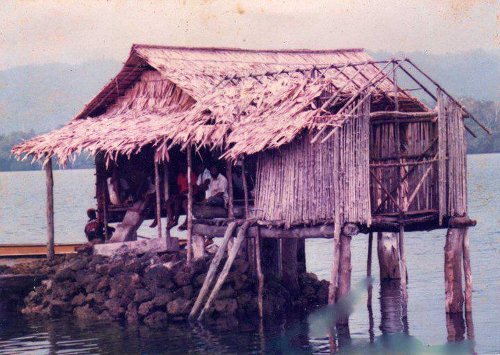
- An important venue for discussion. Life on the artificial island pretty much revolves around a trip to the “tala wane” at least once in a day
Growing up in the Solomon Islands has been a vastly different experience. When I look at my children, I see how much so many things have changed, how different their life has become and will be. This picture reminded me of family vacations we would take to my mother’s home island and the dreaded experience of going to the “tala wane”. A literal translation is “the men’s road” but in actual fact it is the communal toilet since my mother’s village is actually a small but sprawling man-made artificial island in the Lau Lagoon in Malaita Province.
Niuleni island is one of the many artificial islands that litter the northern most tip of the island of Malaita. My mother grew up on this island and years later she would bring us back every year and I loved every moment of time spent on the island.
The closest neighboring artificial island is Ropa to the west of Niuleni. All inhabitants of Niuleni are fishermen and were from the island of Funafou to the east. Two things led to the original move to create a new home, Niuleni. Firstly, the population had grown so big, Funafou was now unable to accommodate everyone. Second and perhaps more importantly, religion. Some inhabitants of Funafou had embraced Christianity and their new-found belief was a contradiction of sorts with the paganism on Funafou that they had been encouraged to forsake. Today, Funafou remains the cultural hub of ancestral life where its inhabitants continue to live their lives mostly untouched by the advent of modernism. I was told that Funafou had served as stopover for the fishermen to be closer to their fishing grounds but it eventually became home too.
Niuleni is literally a collection of smaller artificial islands connected by bridges made of logs and surrounding the church and the “labata”, the playground where all community activities are held. My grandfather, Misifea Bekah’s, own man-island is on the east facing back to his traditional home of Funafou. Beside him was Kuba, the younger Misifea and the only man to own a modern house, Tee. Tee’s house had tinned roof and wall, it was a bold statement in a village of thatched houses. Further down were the Bouro’s, the Maelasi’s and the Kaoni’s…including others I have forgotten now.
Two other very important structures that make up the community life is the “tala wane” (men’s toilet) and the “kabara” (women’s toilet); the segregated community toilets built at least 200m from the main village and again linked by bridges. Going to the toilet on a rainy day or during the night is no easy task.
Besides serving its purpose the “tala wane”, is also an informal meeting place because it had a varendah; where the men would spend hours on days to discuss everything from the weather to planning the next fishing trip. Being a town kid, I dreaded going to “do my business” when a congregation had already formed. In Honiara, the toilet experience was always a private one not a community affair! So we resorted to cleverly timing our visits to very early in the morning or after 8AM when the men had either gone to the market or fishing. On the weekends, especially on Saturday, we waited until everyone was in church before heading off to the “tala wane”. The evenings are a no go since most men would gather and talk well into the night although the darkness provided some privacy.
However, after all these years I stumbled on the photograph posted here and had the chance to see this experience from a different perspective and context. It dawned on me that there was no doubt that many important community decisions were discussed at the “tala wane”. It provided a safe haven for elders to meet informally and reach consensus on important village issues. It served as a place where men would talk about life, politics and current affairs as it would not be surprising to find them huddled over the radio too. To some extent the experience was also therapeutic; time away from the hustle and bustle of village life to reflect on life with a different perspective. Being the furthest structure away from the village it had the best breeze and the best uncluttered view.
The modern world has provided us with the notion of a “thinking throne” but I suppose instincts taught my ancestors that a better perspective on life can be found on “the men’s road”; the “tala wane”.